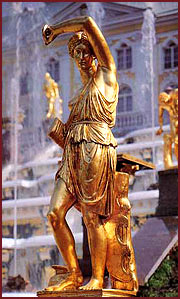 No
visit to St. Petersburg would be complete without a visit to
the beautiful palace of Peterhof (also called Petergof, Petrodvorets
and Peter's Palace). The world-famous palace, fountain and park
ensemble of Peterhof is an outstanding landmark of Russian artistic
culture of the 18-19th centuries. No
visit to St. Petersburg would be complete without a visit to
the beautiful palace of Peterhof (also called Petergof, Petrodvorets
and Peter's Palace). The world-famous palace, fountain and park
ensemble of Peterhof is an outstanding landmark of Russian artistic
culture of the 18-19th centuries.
Founded in the very beginning of the eighteenth century
by Emperor Peter the Great not far
from his new northern capital St Petersburg
(about 30 kilometers west of St. Petersburg.), Peterhof was
intended to become the most splendid official royal summer residence.
|
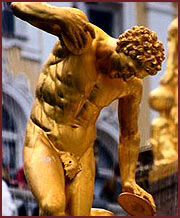 The
main reason to visit Peterhof is to spend the day at Peter's
Palace. The palace is a fabulously ornate structure built to
rival the Palace of Versailles. You can take a guided tour of
the interior of the palace or spend the day strolling through
the formal upper gardens and the park-like lower grounds, with
more than 150 very unique fountains. The
main reason to visit Peterhof is to spend the day at Peter's
Palace. The palace is a fabulously ornate structure built to
rival the Palace of Versailles. You can take a guided tour of
the interior of the palace or spend the day strolling through
the formal upper gardens and the park-like lower grounds, with
more than 150 very unique fountains.
Peterhof (or Petrodvorets), one of the oldest summer
residences in the vicinity of St.Petersburg.
Peterhof means in-German "Peter's Court". Note, that
between 1944 and the early 90s the town was called Petrodvorets,
and some guide books might still list it under that name. It
was founded in 1710, when Peter and Paul Fortress lost its military
significance, and Peter the Great started
to built another fortress on Kotlin Island to protect St.Petersburg.
|
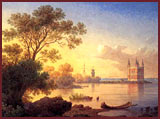 The
Tsar visited the island very often to observe the construction.
He made most of his journeys by boat, on the occasions when
the weather was stormy, rainy, he could wait for the weather
improvement in a small wooden building on a raised site overlooking
the Gulf of Finland. After important victories near Poltava
Peter the Great wanted something more grander, he commissioned
a Versailles-by - the Sea. The
Tsar visited the island very often to observe the construction.
He made most of his journeys by boat, on the occasions when
the weather was stormy, rainy, he could wait for the weather
improvement in a small wooden building on a raised site overlooking
the Gulf of Finland. After important victories near Poltava
Peter the Great wanted something more grander, he commissioned
a Versailles-by - the Sea.
|
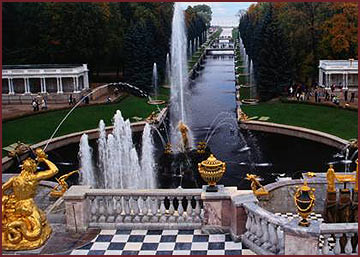
Looking across the Grand Cascade down
Water Ave, an elaborate system of fountains and canals in Peterhof.
|
Attracted by its convenient location between
Kronstadt and St Petersburg, Peter chose it as a stopping place
on his journeys, and named it after himself.
Here, in a grove by the sea, he built a small wooden palace
in 1710. By the end of his reign the wooden palace was altered
and it became known as the"Great Palace", the Monplaisir
Palace was built on the sea front. The Upper Park and the Lower
Park were laid out. First 50 fountains started to play in 1721.
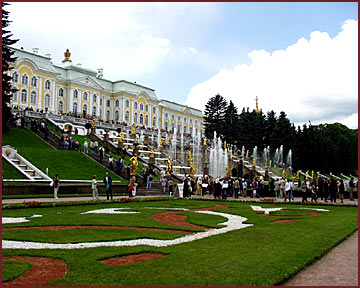 Peter's Palace (Front View)
Peter's Palace (Front View)
|
Peterhof arose, as if by magic, rivalling
in splendour the magnificent park-and-palace complexes of France,
Germany, and Italy, and amazed Europe no less than did the newly-built
St Petersburg itself. It was regarded as an artistic miracle
and as a revelation of the creative abilities of the Russian
people. During Peter's lifetime, Peterhof was already a symbol
of the blossoming of a young, reformed Russia.
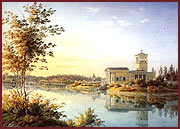 The
focal point of both the Lower Park and the Upper Garden is the
magnificent Grand Palace (Bolshoi Dvorets) with the Grand Cascade
(Bolshoi Kaskad) in front of it. The Grand Cascade, which
goes downhill from the palace towards the Baltic Sea, is one
of the largest fountain ensembles in the world. The
focal point of both the Lower Park and the Upper Garden is the
magnificent Grand Palace (Bolshoi Dvorets) with the Grand Cascade
(Bolshoi Kaskad) in front of it. The Grand Cascade, which
goes downhill from the palace towards the Baltic Sea, is one
of the largest fountain ensembles in the world.
Despite all the damage done to the Grand Palace during
WWII, its interiors have been carefully restored and are truly
breathtaking.
|
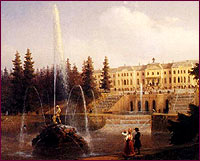 The
Great Cascade in front of the Great Palace flows down twin marble
stairways which flank a deep grotto.The stairs are decorated
with gilded statues,the central basin is a golden Samson opening
the jaws of a golden lion.From the basin,the waterflows toward
the sea through a long canal. The
Great Cascade in front of the Great Palace flows down twin marble
stairways which flank a deep grotto.The stairs are decorated
with gilded statues,the central basin is a golden Samson opening
the jaws of a golden lion.From the basin,the waterflows toward
the sea through a long canal.
At the beginging of the 18th century the canal was rather deep,
the central bridge was an open one, and small sailing ships
brought the quests up to the foot of the palace.The Marine canal
is flanked by rows of trees, more fountains, the jets of water
look like trunks of exotic crystal trees, hence the name of
the alley, the Alley of Fountains.
The present-day aspect of the cascade has been formed
over a century ago, but it was Peter the
Great himself who conceived its general scheme. His first
surviving sketches of the future Peterhof structures show that
the Tsar was familiar with their European prototypes. Peter
the Great offered to erect on the slope of the terrace two grottos
and two cascade stairways to let water run down to a rectangular
pool connected by a canal with the sea.
|
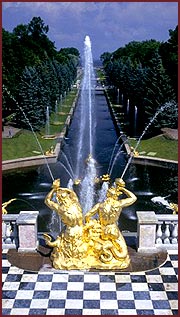 To
provide water for the fountains, a gravity-fed water system,
twenty-two kilometres long, was designed by Vastly Tuvolkov,
the first Russian hydraulic engineer. Skilfully exploiting the
natural slope of the terrain from the springs of Ropsha towards
the sea, he constructed a reliable hydrotechnical system here.
The water-jets of the Great Cascade, and one of the fountains
in the flower parterre of the Lower Gardens in front of the
Great Palace, were turned on for the first time (to test the
water pressure) in the summer of 1721. To
provide water for the fountains, a gravity-fed water system,
twenty-two kilometres long, was designed by Vastly Tuvolkov,
the first Russian hydraulic engineer. Skilfully exploiting the
natural slope of the terrain from the springs of Ropsha towards
the sea, he constructed a reliable hydrotechnical system here.
The water-jets of the Great Cascade, and one of the fountains
in the flower parterre of the Lower Gardens in front of the
Great Palace, were turned on for the first time (to test the
water pressure) in the summer of 1721.
Extended and improved in the first half of the nineteenth
century, this system still supplies enough water to the fountains
and cascades of Peterhof to keep them working for up to ten
hours a day.

|
 |
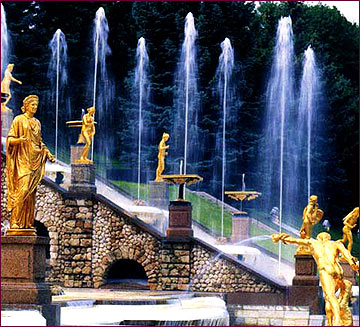
Peterhof. The Western Cascade Stairway. |

|
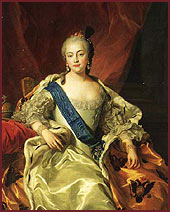 Peterhof is an immensely luxurious royal estate, lying
on the shore of the Gulf of Finland (Baltic Sea), a combination
of several palaces and parks, the "Capital of Russian
fountains". Peterhof is an immensely luxurious royal estate, lying
on the shore of the Gulf of Finland (Baltic Sea), a combination
of several palaces and parks, the "Capital of Russian
fountains".
Empress Elizaberth Petrovna, Peter's
daughter, also took an interest in Peterhof. During her reign
the Great Palace was enlarged, more fountains were added. Peterhof
was even further developed by tzar Nicholas I.
In the eighteenth and nineteenth centuries, the Peterhof
Palace was the central structure of the official, "crowned"
residence of the Russian Emperors.
|
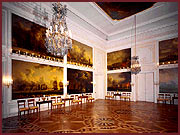 Many
remarkable events took place in its halls, from large-scale
festivals to grand receptions. On festive occasions tables were
laid simultaneously in many halls and even on the terraces under
the galleries of the palace. About three thousand guests gathered
there for great Imperial balls; and the illumination amounted
to over ten thousand candles. Festivities used to last until
morning. Many
remarkable events took place in its halls, from large-scale
festivals to grand receptions. On festive occasions tables were
laid simultaneously in many halls and even on the terraces under
the galleries of the palace. About three thousand guests gathered
there for great Imperial balls; and the illumination amounted
to over ten thousand candles. Festivities used to last until
morning.
|
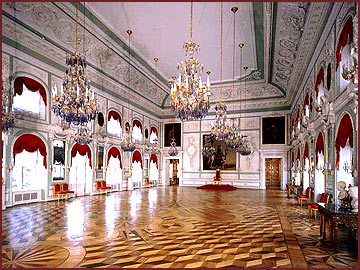
Peterhof. The Throne Room.
Beyond the limits of the seemingly endless royal parks
lies the town of Peterhof. It has a population of 82 thousand
and is renowned throughout Russia for the "Raketa"
wrist-watches, which are produced there.
|
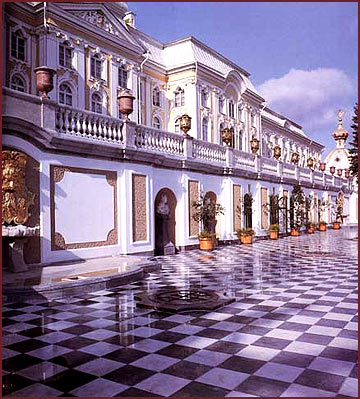 The Great Cascade. The enter to the
Upper Grotto.
The Great Cascade. The enter to the
Upper Grotto.
After the October Revolution of 1917, all the park-and-palace
complexes became national property.
|
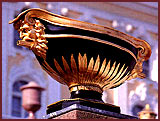 In
the first few months of the Eecond World War of 1941-45, the
staff of the Peterhof museums took all possible measures to
save the art collections. Pictures, statues, and many thousands
of objects of applied art were taken away to Leningrad or to
distant parts of the country. Many marble and bronze sculptures
were buried in the ground or stowed in secret caches. In
the first few months of the Eecond World War of 1941-45, the
staff of the Peterhof museums took all possible measures to
save the art collections. Pictures, statues, and many thousands
of objects of applied art were taken away to Leningrad or to
distant parts of the country. Many marble and bronze sculptures
were buried in the ground or stowed in secret caches.
|
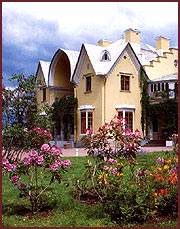 For
twenty-eight months, from 21 September 1941 to 19 January 1944,
Peterhof was in the enemy-occupied territory. The invaders cut
down more than 10,000 of the 30,000 trees in the Lower Park.
The walks and lawns were mined, pitted with trenches, dugouts,
and craters, and fenced with barbed wire. Centuries-old trees
were used to build pill-boxes and bunkers. The Great Palace
was severely damaged by an explosion and a great fire. The Catherine
House in the Monplaisir complex and the Orangery were almost
entirely destroyed. The cascades, fountains, sluices, and canals
of Peterhof, together with those parts of the hydrotechnical
system which fed the Peterhof waterworks with water from Ropsha
springs, suffered serious damage or were completely wrecked. For
twenty-eight months, from 21 September 1941 to 19 January 1944,
Peterhof was in the enemy-occupied territory. The invaders cut
down more than 10,000 of the 30,000 trees in the Lower Park.
The walks and lawns were mined, pitted with trenches, dugouts,
and craters, and fenced with barbed wire. Centuries-old trees
were used to build pill-boxes and bunkers. The Great Palace
was severely damaged by an explosion and a great fire. The Catherine
House in the Monplaisir complex and the Orangery were almost
entirely destroyed. The cascades, fountains, sluices, and canals
of Peterhof, together with those parts of the hydrotechnical
system which fed the Peterhof waterworks with water from Ropsha
springs, suffered serious damage or were completely wrecked.
|
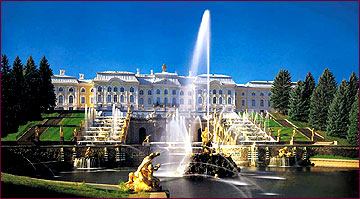 Peterhof. The Great Cascade.
Peterhof. The Great Cascade.
The statues of Samson, the Volkhov, the Neva, and the
Tritons, together with the lead bas-reliefs of the Great Cascade
and many other sculptural works which it had been impossible
to remove to safety, were stolen by the invaders.
The painstaking work was done by the Soviet restorers.
Today eight palaces are open to the public, 173 fountains and
3 Cascades were returned to life. The wide variety of fountains
is the principal feature of Peterhof, its glory. Water plumes
and sprays from hundred of imaginative fountains over statues
of gods and goddesses, horses and fish. |
To see more pictures and learn more about Peterhof please
visit their official
site. |
|


